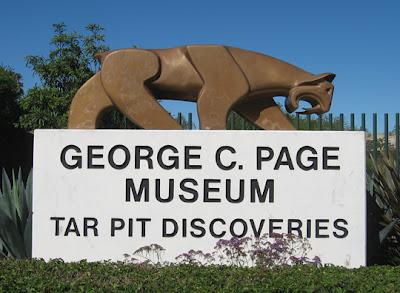 The George C. Page Museum, which houses the Ice Age fossils found in the Rancho La Brea Tar Pits, sits in the heart of the busy city of Los Angeles. The sticky tar found in the area around the museum, not only trapped unwary animals 40,000 years ago, but preserved their bones after they died, providing us with one of the world’s richest sources of information about life in the Ice Age. Recently, when a parking garage was being excavated for the adjacent County Art Museum, a spectacular new cache of fossils was discovered, which included the remains of dire wolves, saber-toothed cats, horses, bison, and ground sloths, as well as hundreds of smaller animals and plants. Most rare of all was a well-preserved male Columbian mammoth fossil, nearly complete, with 10-foot long tusks. He has been nicknamed Zed. Scientists estimate that this new find could double the collection of fossils by three to four million specimens.
The George C. Page Museum, which houses the Ice Age fossils found in the Rancho La Brea Tar Pits, sits in the heart of the busy city of Los Angeles. The sticky tar found in the area around the museum, not only trapped unwary animals 40,000 years ago, but preserved their bones after they died, providing us with one of the world’s richest sources of information about life in the Ice Age. Recently, when a parking garage was being excavated for the adjacent County Art Museum, a spectacular new cache of fossils was discovered, which included the remains of dire wolves, saber-toothed cats, horses, bison, and ground sloths, as well as hundreds of smaller animals and plants. Most rare of all was a well-preserved male Columbian mammoth fossil, nearly complete, with 10-foot long tusks. He has been nicknamed Zed. Scientists estimate that this new find could double the collection of fossils by three to four million specimens.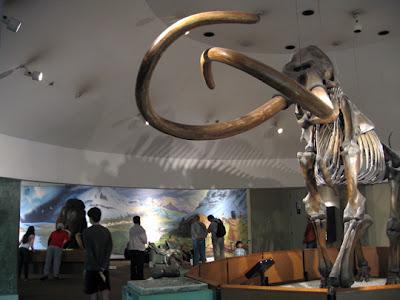 The tar pits and Page Museum are my favorite places to take visitors to Los Angeles. Nowhere else on Earth is there a place like it. In geologic time, 10,000 years ago is quite recent. It is not hard to imagine that if we were living in California back then (and there were Native Americans living in the Los Angeles basin at that time) that we could have had mammoths in our back yards. The fact that the tar has preserved so many of the animals that lived in California during the Ice Age, and which are now extinct, makes the La Brea discoveries unique.
The tar pits and Page Museum are my favorite places to take visitors to Los Angeles. Nowhere else on Earth is there a place like it. In geologic time, 10,000 years ago is quite recent. It is not hard to imagine that if we were living in California back then (and there were Native Americans living in the Los Angeles basin at that time) that we could have had mammoths in our back yards. The fact that the tar has preserved so many of the animals that lived in California during the Ice Age, and which are now extinct, makes the La Brea discoveries unique.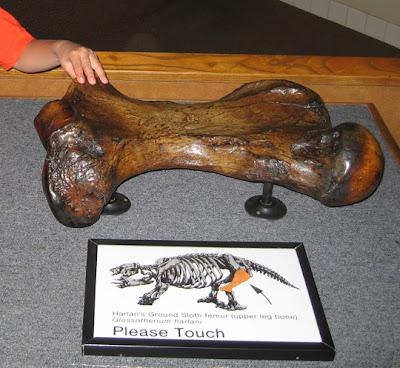 The Rancho La Brea Tar Pits are on land that once belonged to Captain G. Allen Hancock, who operated oil wells there. Today, the oil wells are gone, and the land is a county park named after Captain Hancock. In the park are both the tar pits, including pit 91 which is still being excavated, and the George C. Page Museum of La Brea Discoveries. Several models of Ice Age animals, including giant ground sloths and a short-faced bear, are also located in the park. In the lake outside the museum, models of a mother and baby mammoth appear to be sinking into the tar, just as real mammoths met their deaths in the past.
The Rancho La Brea Tar Pits are on land that once belonged to Captain G. Allen Hancock, who operated oil wells there. Today, the oil wells are gone, and the land is a county park named after Captain Hancock. In the park are both the tar pits, including pit 91 which is still being excavated, and the George C. Page Museum of La Brea Discoveries. Several models of Ice Age animals, including giant ground sloths and a short-faced bear, are also located in the park. In the lake outside the museum, models of a mother and baby mammoth appear to be sinking into the tar, just as real mammoths met their deaths in the past.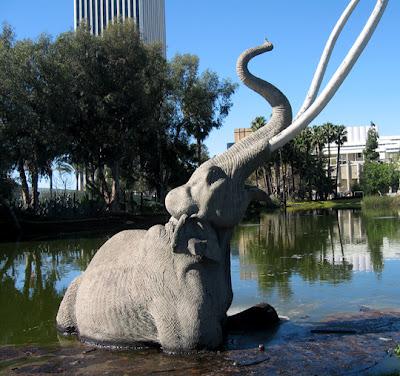 The remains of over 420 different kinds of animals are among the Rancho La Brea discoveries. Most fossils found at Rancho La Brea are used for scientific research, but inside the museum are representative examples of all the larger animals, providing visitors with an appreciation of the enormous variety of life that roamed the Los Angeles basin 10,000 to 40,000 years ago. Many of the bones excavated from the tar pits are of predators–dire wolves, sabertooth cats, American lions (yes, North America did once have lions), and short-faced bears. One of my favorite exhibits is a frieze of dire wolf skulls. The remains of more than 1600 dire wolves, more than those of any other single animal, have been found at Rancho La Brea. The wolves hunted in packs. When their prey became stuck in tar and they jumped on to attack it, the wolves often became victims of the tar as well.
The remains of over 420 different kinds of animals are among the Rancho La Brea discoveries. Most fossils found at Rancho La Brea are used for scientific research, but inside the museum are representative examples of all the larger animals, providing visitors with an appreciation of the enormous variety of life that roamed the Los Angeles basin 10,000 to 40,000 years ago. Many of the bones excavated from the tar pits are of predators–dire wolves, sabertooth cats, American lions (yes, North America did once have lions), and short-faced bears. One of my favorite exhibits is a frieze of dire wolf skulls. The remains of more than 1600 dire wolves, more than those of any other single animal, have been found at Rancho La Brea. The wolves hunted in packs. When their prey became stuck in tar and they jumped on to attack it, the wolves often became victims of the tar as well.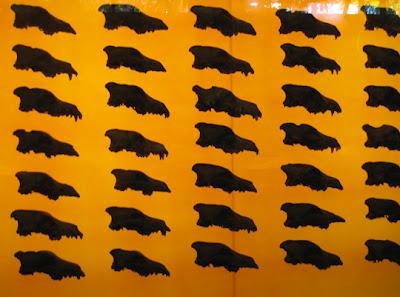 The museum is very kid-friendly, with numerous hands-on exhibits. You can touch a fossil bone, try to pull a rod out of sticky tar, or listen to the roar of an animated wooly mammoth. I always take visitors to watch the short movie that introduces the museum and gives an overview of the Ice Age and tar pit discoveries. You can also look through a window into the lab and see people cleaning and sorting fossils. Some of the most important finds are the micro-fossils, small bits of plants, seeds, bones, and other remains that provide clues to the overall environment.
The museum is very kid-friendly, with numerous hands-on exhibits. You can touch a fossil bone, try to pull a rod out of sticky tar, or listen to the roar of an animated wooly mammoth. I always take visitors to watch the short movie that introduces the museum and gives an overview of the Ice Age and tar pit discoveries. You can also look through a window into the lab and see people cleaning and sorting fossils. Some of the most important finds are the micro-fossils, small bits of plants, seeds, bones, and other remains that provide clues to the overall environment.Details:
The Page Museum is open 9:30 to 5:00 pm every day of the year except July 4, Thanksgiving Day, December 25 and January 1. For information about tickets, parking, directions, and everything you need to know to plan a visit, go the the Page Museum website plan-your-trip page.
